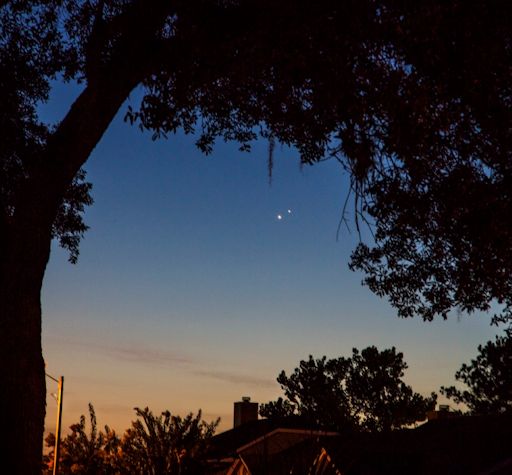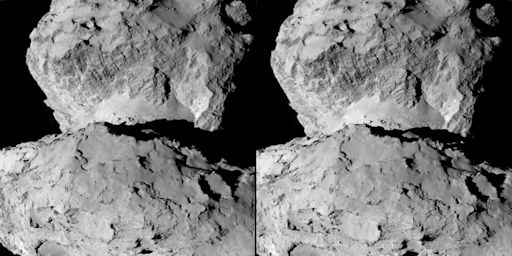When is the best time to see auroras? Where is the best place to go? And how do you photograph them? These questions and more are answered in a new book, Northern Lights - a Guide, by Pal Brekke & Fredrik Broms. | | | CHANCE OF MINOR STORMS: NOAA forecasters estimate a 30% chance of polar geomagnetic storms on August 18th when a faint CME is expected to strike Earth's magnetic field head-on. This is not a major event. Nevertheless, high-latitude sky watchers should be alert for auroras when the CME arrives. Follow the action @spaceweatherman. MORNING PLANETS: Did you see that? This morning Venus and Jupiter converged in the pre-dawn sky for a spectacular conjunction. At closest aproach they were barely 0.2o apart. Richard S. Wright Jr. sends this picture from Lake Mary, Florida: 
"This was worth setting my alarm for this morning," says Wright. "Jupiter and Venus were so close together, and rapidly rising as the sky brightened. I grabbed my tripod and caught them under my neighbors trees." The planets are separating now, but not too quickly. They will still be a beautiful pair for the rest of the week. A date of special interest is August 23rd when the crescent Moon joins the planets to form a bright celestial triangle in the eastern pre-dawn sky. Observing tips: Go outside 60 minutes before sunrise and look east-northeast. No telescope is required. Jupiter and Venus are bright enough to see with the naked eye even from light polluted cities. Try following the bright pair after the dawn sky begins to brighten. A tight conjunction of Venus and Jupiter framed by twilight blue is a great way to start the day. For more information, see this video from NASA. Realtime Conjunction Photo Gallery THE LANDSCAPE OF A COMET--NOW IN 3D: For the past few days, we have highlighted a recent image of Comet 67P/Churyumov-Gerasimenko taken by Europe's Rosetta spacecraft. Spaceweather.com reader Hanno Falk of Germany has taken that image to a new level by adding a 3rd dimension. Click on the graphic below, then cross your eyes to merge the two nuclei. Oh, and be careful not to fall over the cliff: 
Falk created the cross-eyed view by combining two images taken by Rosetta 17 minutes apart. ESA did the same thing to make a 3D anaglyph. The problem with anaglyphs is that they require 3D glasses. Falk's version requires only two eyes. The 3D view reveals a deep canyon separating the two lobes of 67P's core. The canyon's smooth floor is peppered with boulders, while the highlands outside the canyon are jagged and dimpled by crater-like depressions. Now imagine this magnificent landscape ruptured by dozens of geysers spewing dust and gas into space. Future pictures may show exactly that. Rosetta will follow this comet for more than a year as it approaches the sun. In 2015, if not sooner, solar heating will activate the comet's icy core, creating a riot of activity the likes of which no spacecraft has ever seen before. Stay tuned for that. Realtime Comet Photo Gallery
Realtime Meteor Photo Gallery
Realtime Aurora Photo Gallery
Realtime NLC Photo Gallery
Every night, a network of NASA all-sky cameras scans the skies above the United States for meteoritic fireballs. Automated software maintained by NASA's Meteoroid Environment Office calculates their orbits, velocity, penetration depth in Earth's atmosphere and many other characteristics. Daily results are presented here on Spaceweather.com. On Aug. 18, 2014, the network reported 59 fireballs.
(58 sporadics, 1 Perseid)  In this diagram of the inner solar system, all of the fireball orbits intersect at a single point--Earth. The orbits are color-coded by velocity, from slow (red) to fast (blue). [Larger image] [movies] Potentially Hazardous Asteroids ( PHAs) are space rocks larger than approximately 100m that can come closer to Earth than 0.05 AU. None of the known PHAs is on a collision course with our planet, although astronomers are finding new ones all the time. On August 18, 2014 there were 1494 potentially hazardous asteroids. Notes: LD means "Lunar Distance." 1 LD = 384,401 km, the distance between Earth and the Moon. 1 LD also equals 0.00256 AU. MAG is the visual magnitude of the asteroid on the date of closest approach. | | The official U.S. government space weather bureau | | | The first place to look for information about sundogs, pillars, rainbows and related phenomena. | | | Researchers call it a "Hubble for the sun." SDO is the most advanced solar observatory ever. | | | 3D views of the sun from NASA's Solar and Terrestrial Relations Observatory | | | Realtime and archival images of the Sun from SOHO. | | | from the NOAA Space Environment Center | | | the underlying science of space weather | | 
